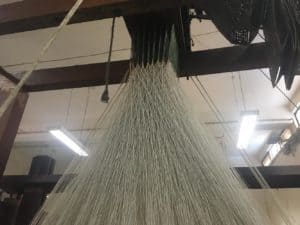Weavers are facing marketing and financial problems. Ironically, hand-woven textiles continue to be the prerogative of the elite despite initiatives to make it a product for the masses
This year on National Handloom Day — observed on August 7every year — a team of the Indian designer label Raw Mango took to the streets of Delhi to ask people what they knew about handloom. Most people were clueless, contemplating the combined usage of hand and loom, trying to make sense out of their vague understanding of hand-woven fabrics.
The initiative that was broadcast as stories on the label’s Instagram page, got many of us thinking about the efforts the label has made in all these years for educating the public about what handloom really stands for. The activity seemed a bit pointless coming from a clothing label that primarily uses traditional Indian hand woven textiles to create exquisite ensembles for its privileged class clientele.
Irrespective of the designer shops that have opened up in the country in the recent past, there are Weaver’s Service Centres, under the aegis of the Ministry of Textiles, that facilitate government efforts to spread awareness and to train people, especially the weavers’ community, on how they can make hand loom viable in the days of mill-made fabrics taking over the wardrobes.
 One such center that operates in the interiors of Bharat Nagar in North West Delhi gives us an idea of the functioning of these weavers’ centers. What feels like a quaint place, has enough green area to give shade to its employees and visitors. KN Uniyal, an assistant director serving the last few months at the center before he gets retired, talking about the primary role of the WSCs, says, “We are here to support anyone who wants to explore weaving as a technique.”. He explains the various courses available for those who want to get into the business of handloom or learn the technique, with major departments being weaving, designing and dyeing. “There are students who come and learn weaving. We also have businessmen coming to us for assistance when they cannot get a complex weave right or to simply get a sample made,” he adds. Apart from this, workshops are conducted from time to time for weavers to help them upgrade their skills.
One such center that operates in the interiors of Bharat Nagar in North West Delhi gives us an idea of the functioning of these weavers’ centers. What feels like a quaint place, has enough green area to give shade to its employees and visitors. KN Uniyal, an assistant director serving the last few months at the center before he gets retired, talking about the primary role of the WSCs, says, “We are here to support anyone who wants to explore weaving as a technique.”. He explains the various courses available for those who want to get into the business of handloom or learn the technique, with major departments being weaving, designing and dyeing. “There are students who come and learn weaving. We also have businessmen coming to us for assistance when they cannot get a complex weave right or to simply get a sample made,” he adds. Apart from this, workshops are conducted from time to time for weavers to help them upgrade their skills.
As the Delhi centre is responsible for all the regions in North India, Uniyal shares how they are setting up a micro centre in Kullu to introduce Jacquard and Dobby looms to the community practicing weaving there. “In Kullu, weaving is one of the important practices after farming. Woven shawls are a bestseller there and we are trying to introduce new looms to weavers that can help them create new designs,” he informs.
He also praises the success of Bhuttico — a cooperative from Kullu helmed by the chairman, Satya Prakash Rathore — that is able to sustain not just the weavers but also the craft among the buyers.
Products that are indigenous and priced optimally for local consumption are retailed through various flagship stores in the country. “They are a society of weavers living together, like a commune. Their kids go to the same school and they have their own culture. That is exactly my suggestion to the Indian government. We should set up a society for weavers, with colonies for them to live and work.”
In Uniyal’s opinion, everything is being taken care of and weavers have enough expertise in their work but there are a number of factors that hold back many independent weavers to not find suitable work and ending up discontinuing the craft itself. According to him, there is a serious problem of marketing. While weavers have the ability to create good quality products, they are not able to find the market they can tap. Also, the meagre wage becomes a problem for many weavers, compelling them to take up other jobs. Weaving is a labour intensive job and one needs to earn a bare minimum for survival. Uniyal says that children of these weavers who are educated and tech-savvy are considering other career options .
While the business of hand woven textiles remains for the elite few on the backs of multiple designer brands being able to hire weavers back in the villages, the story that the weavers service center tells us is a sad one — where everyone is abandoning the art of weaving that has lived through years of practice, rigour and heritage. There are brands like FabIndia doing their bit to create a market for artisanal products for the middle class in India but it is extremely tricky to design for the masses. It is after all a common man who is the maker of these painstakingly woven textiles. From what we know of Gandhi’s idea of Khadi, it is for the public and must remain so.





